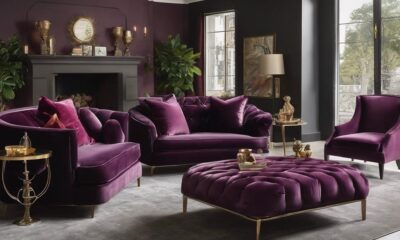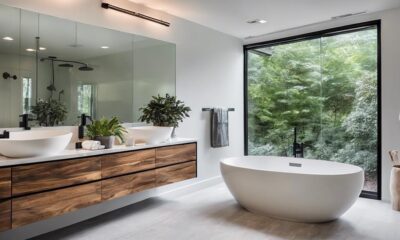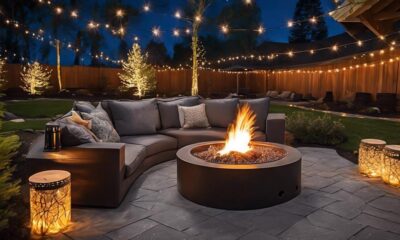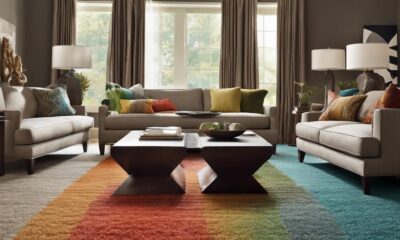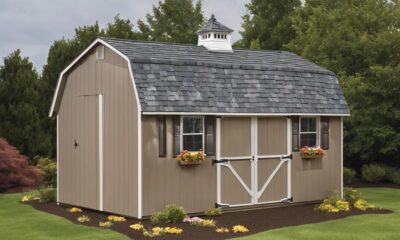Appliances
What Are the Pros and Cons of a Ceiling Fan?
2025
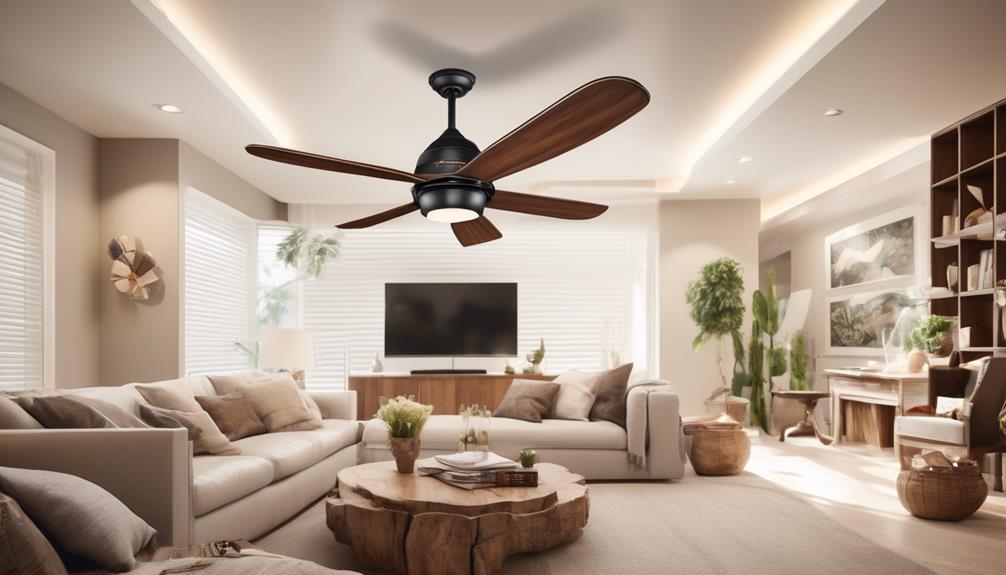
We recognize that there might be doubts about the feasibility of mounting a ceiling fan. Nonetheless, it’s crucial to reflect on the numerous advantages this straightforward but efficient device provides.
Ceiling fans are known for their energy efficiency, helping to reduce reliance on air conditioning and lowering utility bills. They provide cost-effective cooling, circulating air to create a comfortable environment without the need for excessive energy consumption.
Additionally, ceiling fans improve air circulation, preventing stagnant air and reducing the need for additional cooling or heating systems.
While there are considerations to be made, such as noise levels and maintenance requirements, the pros of a ceiling fan outweigh the cons.
Let's explore the various advantages and disadvantages to make an informed decision about this popular home appliance.
Energy Efficiency
When it comes to energy efficiency, ceiling fans provide a viable option for cooling and air circulation in a cost-effective and environmentally friendly manner. Ceiling fans consume significantly less energy compared to air conditioners, resulting in substantial cost savings. They can cool a room by up to 4 degrees Fahrenheit, allowing you to set your thermostat higher and reduce your air conditioning usage. This reduction in energy consumption translates to lower electricity bills and long-term cost savings.
Another advantage of ceiling fans is their minimal environmental impact. By using less electricity, you contribute to reducing greenhouse gas emissions and overall energy consumption. This helps combat climate change and promotes a more sustainable future. Furthermore, ceiling fans don't rely on harmful refrigerants like air conditioners do, which can have a detrimental effect on the ozone layer and contribute to global warming.
Cost-Effective Cooling
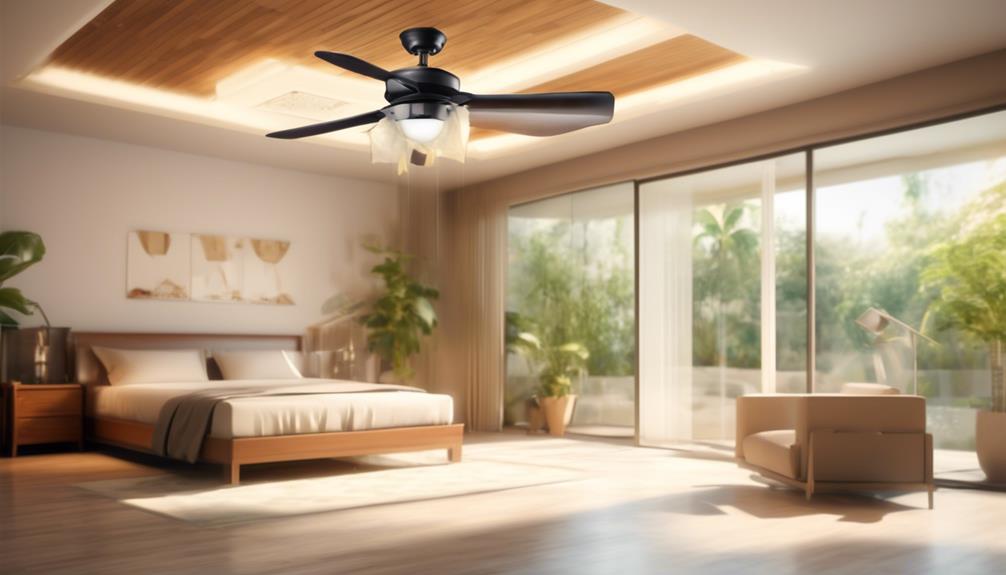
When it comes to cost-effective cooling, ceiling fans offer an energy-saving alternative to air conditioning. By circulating the air and creating a breeze, they allow for a more comfortable environment without the high energy consumption of AC units.
Additionally, their adjustable settings provide flexibility in air circulation, allowing users to customize their cooling experience.
Furthermore, ceiling fans can be used year-round as they also help distribute warm air during the winter months, making them a practical investment for any home.
Energy-Saving Alternative
Ceiling fans provide a cost-effective and energy-saving alternative for cooling your home. Not only do they create a comfortable indoor environment, but they also offer numerous energy-saving benefits. By using ceiling fans in conjunction with your air conditioning system, you can reduce your reliance on air conditioning and lower your energy consumption. This can result in significant cost savings over time.
Here is a comparison table highlighting the energy-saving benefits of ceiling fans:
| Energy-saving Benefits | Environmental Impact |
|---|---|
| Reduces air conditioning usage | Decreases carbon footprint |
| Lowers energy consumption | Reduces greenhouse gas emissions |
| Decreases electricity bills | Saves natural resources |
| Provides efficient cooling | Minimizes environmental impact |
| Improves indoor air circulation | Promotes sustainability |
Adjustable Air Circulation
Adjustable air circulation provided by ceiling fans offers a cost-effective cooling solution for your home. With the ability to adjust the fan speed, you can easily control the amount of airflow in the room, ensuring optimal comfort.
Here are some benefits of adjustable air circulation with ceiling fans:
- Energy efficiency: By using a ceiling fan with adjustable speed, you can reduce your reliance on air conditioning, leading to lower energy consumption and utility bills.
- Remote control convenience: Many ceiling fans come with a remote control, allowing you to conveniently adjust the fan speed and airflow from anywhere in the room.
- Customizable comfort: With adjustable speed settings, you can personalize the airflow to suit your preferences and create a comfortable environment.
- Year-round use: Ceiling fans can be used in both summer and winter. In summer, they provide a cooling breeze, while in winter, they can be used to circulate warm air, improving heating efficiency.
- Versatility: Adjustable air circulation makes ceiling fans suitable for any room size or layout, ensuring consistent airflow throughout your home.
Year-Round Functionality
To maximize cost-effective cooling throughout the year, ceiling fans offer a versatile solution that can be adjusted to suit your comfort needs. Their year-round functionality makes them an excellent addition to any home.
During the warmer months, ceiling fans can be set to rotate counterclockwise, creating a cooling breeze that helps to lower the temperature. This can reduce the reliance on air conditioning, resulting in energy savings and lower utility bills.
In the colder months, ceiling fans can be set to rotate clockwise, which pushes warm air downwards and helps to distribute it evenly throughout the room. This can enhance the efficiency of heating systems and provide added comfort.
With their energy-efficient design, ceiling fans are a smart choice for maintaining a comfortable environment while minimizing energy consumption.
Improved Air Circulation
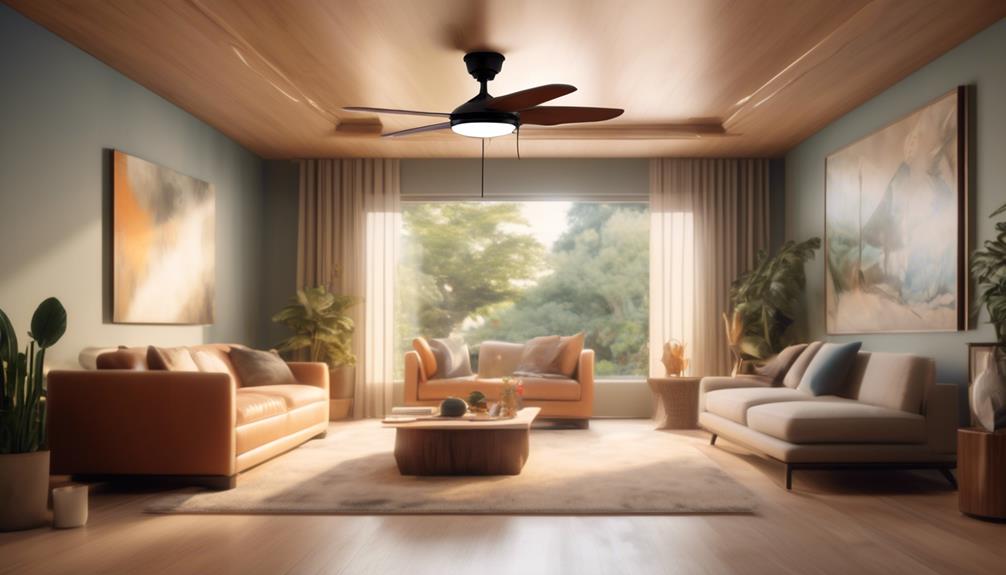
Installing a ceiling fan can greatly enhance air circulation in any room. Here are some reasons why improved air circulation is beneficial:
- Increased comfort: A ceiling fan helps distribute cool air from an air conditioner or natural breeze more evenly throughout the room, creating a more pleasant and comfortable environment. It can also help in the winter by circulating warm air from the heating system.
- Reduced energy consumption: By using a ceiling fan, you can rely less on air conditioning or heating systems, resulting in lower energy consumption and reduced utility bills. Since a fan uses less electricity than an AC unit, it's a more energy-efficient option.
- Better air quality: The improved air circulation provided by a ceiling fan can help prevent stale or stagnant air, reducing the risk of odors, mold, and mildew. It also aids in ventilating smoke or cooking fumes, making the room fresher and more breathable.
- Enhanced ventilation: Ceiling fans are particularly useful in rooms without windows or with limited natural ventilation. They help to circulate fresh air and remove stuffiness, creating a healthier and more pleasant indoor environment.
- Noise reduction: In addition to improving air circulation, ceiling fans can also produce a gentle, soothing sound that can mask background noise and promote relaxation, making them ideal for bedrooms or quiet spaces.
Versatile Design Options
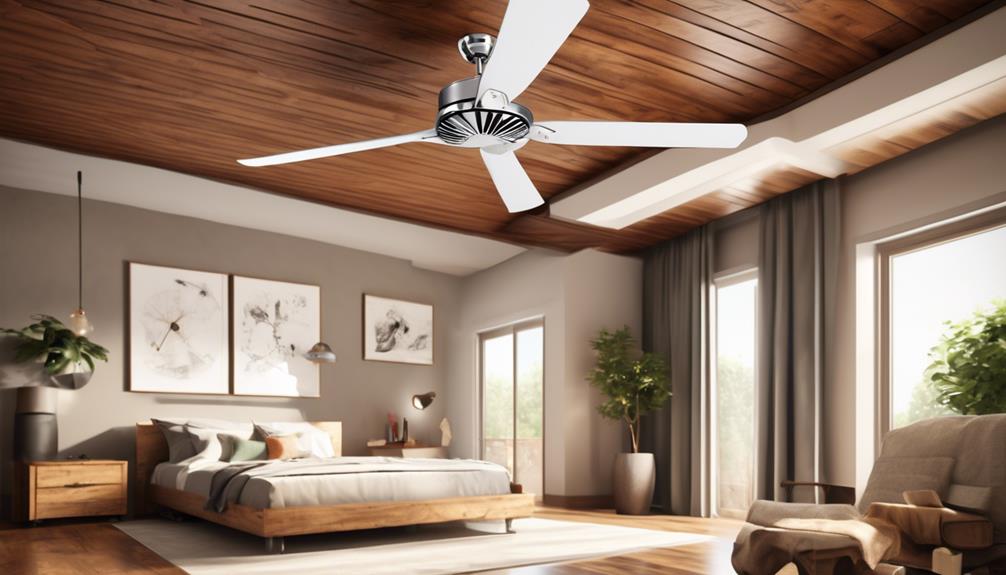
Continuing our discussion on the benefits of improved air circulation, let's now explore the versatile design options that ceiling fans offer.
Ceiling fans come in a wide range of designs, ensuring that there's something to suit every style and preference. Whether you prefer a sleek and modern look or a more traditional aesthetic, there's a ceiling fan that can complement your decor.
One of the key advantages of ceiling fans is their ability to provide adjustable air circulation. Most ceiling fans come with multiple speed settings, allowing you to customize the airflow to your liking. This feature is particularly useful during different seasons or times of the day when you may require varying levels of air movement.
Additionally, many ceiling fans also have a reversible motor, which allows you to change the direction of the blades. This feature enables the fan to be used year-round, as it can help to cool you down in the summer and distribute warm air during the winter months.
Furthermore, ceiling fans offer a variety of control options, including wall-mounted controls, remote controls, and even smart home integration. This versatility allows you to easily adjust the fan's speed and direction without having to get up from your seat.
Some ceiling fans even come with built-in lighting fixtures, providing both functionality and style in one package.
Noise Levels
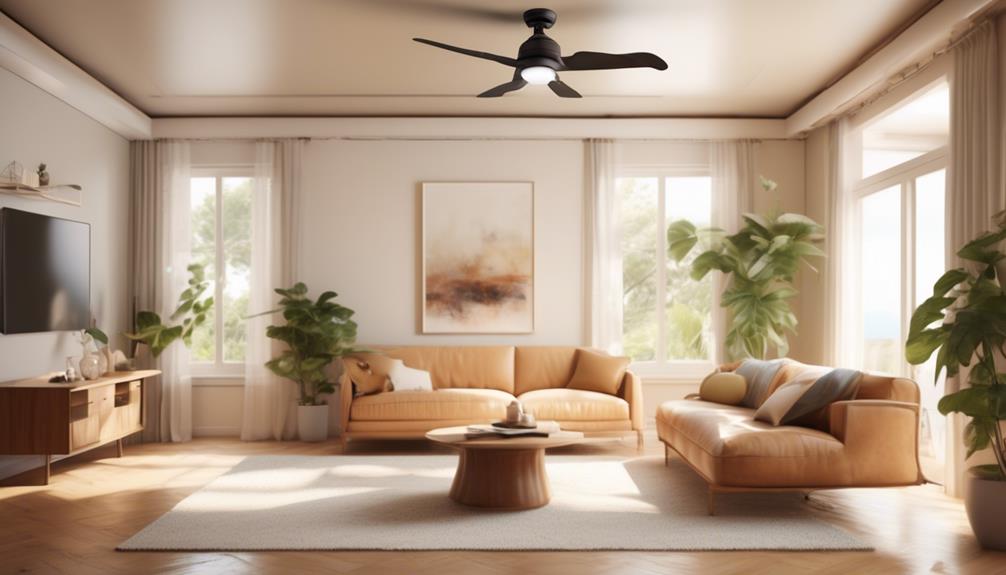
When it comes to ceiling fans, the noise levels are an important consideration. Understanding the noise levels of different fans can help determine their impact on the ambience of a room.
This is especially crucial for bedrooms, where a quiet fan is essential for a good night's sleep.
Noise Levels Explained
Noise levels in ceiling fans can vary greatly depending on the quality of the fan and its components. Understanding noise reduction and decibel levels can help homeowners make informed decisions when selecting a ceiling fan. Here are some key points to consider:
- Noise reduction: High-quality fans are designed with noise reduction in mind. They feature advanced motor technology and enhanced blade designs to minimize noise during operation.
- Decibel levels: Ceiling fans typically produce sound levels between 30 to 60 decibels. Quieter fans are preferred for bedrooms and quiet spaces, while slightly noisier fans may be more suitable for larger areas like living rooms.
- Motor quality: Fans with higher-quality motors tend to operate more quietly. Look for fans with efficient, well-constructed motors to reduce noise levels.
- Blade design: The shape and size of the fan blades can impact noise production. Fans with well-designed blades can create a more balanced airflow and reduce noise.
- Installation: Proper installation is crucial for minimizing noise. Ensure that the fan is securely mounted and that all components are tightly connected to prevent rattling or vibrating noises.
Understanding these factors can help homeowners choose a ceiling fan that provides both comfort and quiet operation.
Impact on Ambience
Ceiling fan noise levels can significantly impact the ambience of a room, influencing the overall comfort and tranquility of the space. When choosing a ceiling fan, it's important to consider the noise levels it produces. Excessive noise can disrupt the peaceful atmosphere and hinder relaxation.
However, modern ceiling fans are designed with improved comfort in mind, and many models now feature noise-reducing technology. By opting for a fan with low noise levels, you can enjoy the benefits of improved air circulation without compromising on the serene environment.
Additionally, some ceiling fans come with built-in ambient lighting options, further enhancing the overall ambience of the room. These features allow you to create a soothing and inviting atmosphere, making your space more enjoyable and relaxing.
Consideration for Bedrooms
Considering the impact of noise levels, it's crucial to take into account the suitability of a ceiling fan for a bedroom. While ceiling fans provide numerous benefits for bedroom decor, they can also affect sleep quality due to their noise levels. Here are some factors to consider:
- Noise level: Ensure the fan operates quietly, as excessive noise can disrupt sleep and hinder relaxation.
- Blade design: Opt for fans with specially designed blades to minimize noise and create a soothing airflow.
- Motor quality: Choose a fan with a high-quality motor that operates quietly at various speeds.
- Installation: Proper installation can reduce noise levels, so consult a professional if needed.
- Maintenance: Regular cleaning and lubrication of the fan can help maintain its quiet operation.
Maintenance Requirements
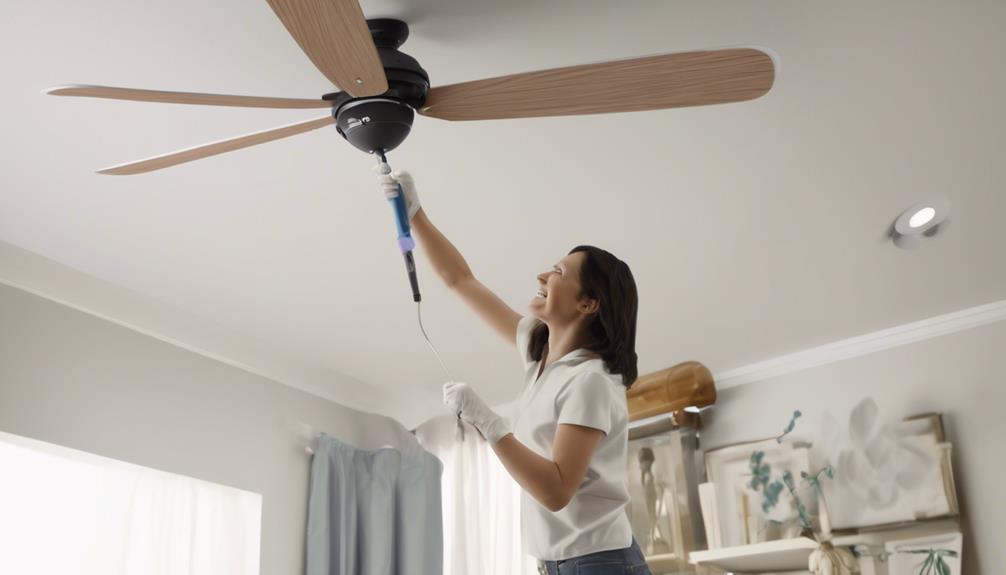
Regular maintenance is essential for ensuring the optimal performance and longevity of a ceiling fan. By following the recommended maintenance requirements, you can keep your ceiling fan running smoothly and efficiently for years to come.
One important aspect of maintenance is to regularly clean your ceiling fan. Dust and dirt can accumulate on the blades, causing the fan to operate less effectively. Use a soft cloth or duster to remove any debris from the blades and motor housing. Additionally, you may need to use a mild detergent and water to clean more stubborn stains. Be sure to turn off the power to the fan before cleaning.
Another potential issue to be aware of is wobbling. If your ceiling fan starts to wobble, it could be a sign of an imbalance. This can be caused by a variety of factors, such as loose screws or a bent blade. Regularly check the fan's balance and tighten any loose screws. If the wobbling persists, you may need to replace a bent blade or seek professional assistance.
Potential for Wobbling
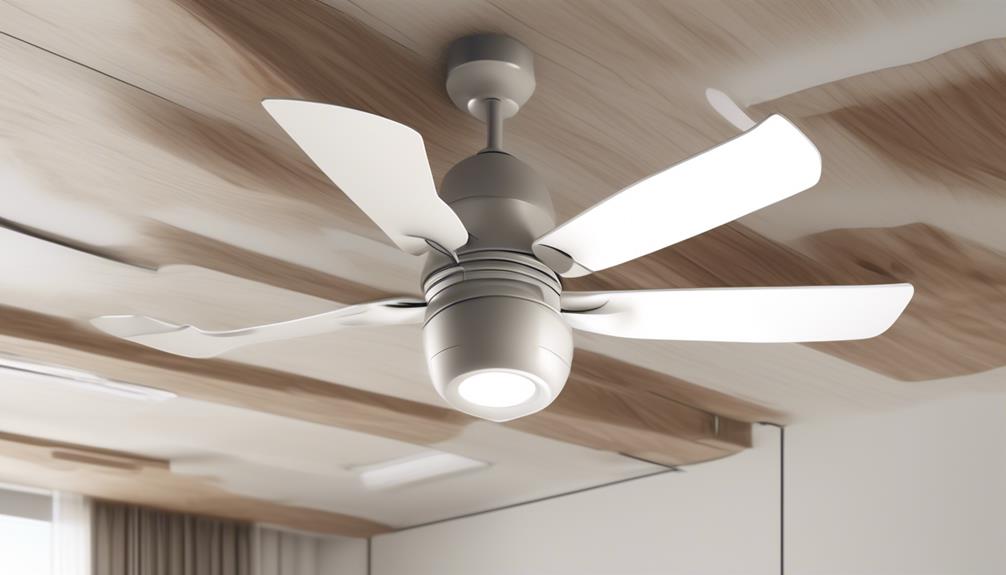
Wobbling is a potential issue that can occur with ceiling fans, indicating an imbalance that may need to be addressed. It's important to prevent wobbling as it can affect the overall performance and stability of the fan.
Here are some tips to improve stability and prevent wobbling:
- Ensure proper installation: Make sure the ceiling fan is securely mounted to a stable ceiling joist or support structure. Use a mounting bracket that's designed for your specific fan model.
- Check for loose parts: Regularly inspect and tighten any loose screws, bolts, or brackets that may be contributing to the wobbling.
- Balance the blades: Use a balancing kit or blade balancing technique to ensure that all the blades are evenly weighted. This can help reduce wobbling caused by blade imbalances.
- Use a downrod: If your ceiling fan is installed on a sloped ceiling, consider using a downrod. This can help maintain balance and stability by keeping the fan level.
- Regular maintenance: Clean the fan regularly to prevent dust buildup, which can affect the balance and cause wobbling. Also, lubricate the fan's moving parts as recommended by the manufacturer.
Limited Heating Capabilities
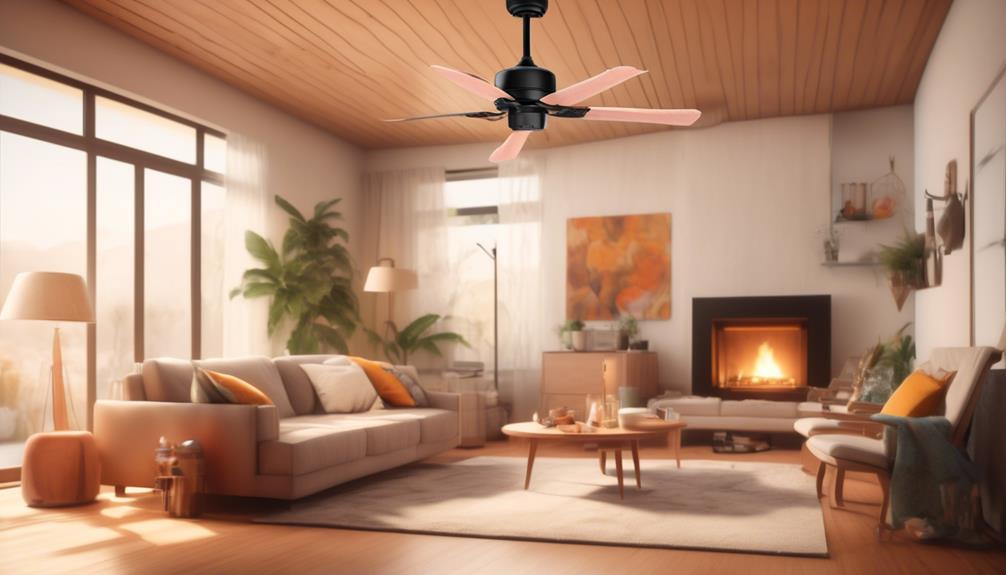
To address another potential drawback, it's essential to understand the limited heating capabilities of ceiling fans. While ceiling fans are primarily known for their cooling abilities, they can also be used to circulate warm air during colder months. However, it's important to note that the heating capabilities of ceiling fans are limited.
Ceiling fans don't generate heat themselves; instead, they redistribute existing warm air in the room. This means that they aren't as efficient as dedicated heating systems when it comes to warming up a space. The effectiveness of a ceiling fan in heating a room depends on various factors, such as the size of the room, the height of the ceiling, and the efficiency of the heating source.
Furthermore, ceiling fans are designed to move air in a downward direction. This can create a cooling breeze during hot weather, but it can also result in a drafty feeling when used for heating purposes. This is especially true if the fan is set to a high speed.
Can a Ceiling Fan Really Help with Air Circulation?
Yes, a ceiling fan can definitely help with air circulation. A ceiling fan effectiveness analysis will show that these fans can improve airflow and create a more comfortable environment in a room. By constantly moving air, ceiling fans can help distribute both warm and cool air, making a space feel more balanced and comfortable.
Frequently Asked Questions
Can Ceiling Fans Be Used in Outdoor Spaces?
Outdoor ceiling fans can be a great addition to any outdoor space. They offer several benefits, such as providing a cool breeze on hot summer days and keeping bugs away.
Additionally, outdoor ceiling fans can help to circulate air and improve ventilation in outdoor areas. Whether you have a patio, deck, or outdoor living space, installing an outdoor ceiling fan can enhance your comfort and enjoyment of the outdoors.
What Is the Average Lifespan of a Ceiling Fan?
The average lifespan of a ceiling fan can vary depending on several factors.
Proper ceiling fan maintenance, such as regularly cleaning and lubricating the fan, can extend its lifespan.
Additionally, choosing a high-quality ceiling fan from a reputable brand can also contribute to its longevity.
It's important to consider these factors when selecting a ceiling fan, as a well-maintained and durable fan can provide years of efficient and reliable cooling.
Are There Any Safety Concerns Associated With Ceiling Fans?
Ceiling fan safety is an important consideration for homeowners. Regular maintenance is crucial to ensure safe operation.
Some safety concerns include:
- Loose blades
- Electrical issues
- Improper installation
To mitigate these risks, it's recommended to:
- Regularly tighten screws and check for any loose parts
- Avoid overloading the fan with heavy attachments
- Have a professional electrician handle installation
Following these maintenance tips will help ensure a safe and efficient ceiling fan in your home.
Can a Ceiling Fan Help Reduce Allergies or Improve Indoor Air Quality?
Ceiling fans are like magical air wizards, whisking away our allergies and improving indoor air quality. While they may not have actual wizard powers, they can certainly help circulate air and reduce allergens in the home.
Regular ceiling fan maintenance, such as cleaning the blades and replacing filters, can further enhance their efficiency. Additionally, ceiling fans are energy efficient, making them a cost-effective and environmentally friendly choice.
Are There Any Specific Installation Requirements for Ceiling Fans?
When it comes to ceiling fan installation, there are some key tips and best practices to keep in mind.
Ensuring that the fan is securely mounted and balanced is essential for its proper functioning.
It's also important to follow the manufacturer's instructions and use the appropriate wiring and electrical connections.
Additionally, proper installation includes choosing the right size fan for the room and installing it at the correct height for optimal airflow.
Taking these steps will help ensure a successful ceiling fan installation.
Conclusion
In conclusion, ceiling fans offer a plethora of benefits such as energy efficiency, cost-effective cooling, improved air circulation, and versatile design options.
However, they do have drawbacks, including potential noise levels, maintenance requirements, and the potential for wobbling.
While they lack heating capabilities, their overall advantages make them a worthwhile addition to any space.
So, if you seek a stylish and efficient cooling solution, consider installing a ceiling fan and feel the refreshing breeze in your abode.
- About the Author
- Latest Posts
Introducing Ron, the home decor aficionado at ByRetreat, whose passion for creating beautiful and inviting spaces is at the heart of his work. With his deep knowledge of home decor and his innate sense of style, Ron brings a wealth of expertise and a keen eye for detail to the ByRetreat team.
Ron’s love for home decor goes beyond aesthetics; he understands that our surroundings play a significant role in our overall well-being and productivity. With this in mind, Ron is dedicated to transforming remote workspaces into havens of comfort, functionality, and beauty.
Garage Door Opener
What Are the Benefits of a Bicycle Garage Door Opener?
Harness the power of convenience with a bicycle garage door opener, transforming your cycling routine with effortless access – discover the hidden benefits that await!

Have you ever thought about how a bicycle garage door opener could transform your cycling routine?
The benefits extend beyond mere convenience, offering a seamless way to access your garage effortlessly.
But that's just the beginning.
By exploring the various advantages this innovative device brings to cyclists, you will discover a whole new dimension to your riding experience.
Key Takeaways
- Seamless and hands-free operation for quick bike access.
- Enhanced security features with remote access control.
- Space optimization in the garage for easy bike storage.
- Integration with smart home technology for remote control and automation.
Enhanced Convenience and Accessibility
Bicycle garage door openers revolutionize the way cyclists access their garages by providing seamless and hands-free operation. These innovative garage door openers allow cyclists to effortlessly open and close their garage doors without the need to dismount from their bikes. With wireless capabilities, users can operate the garage door from a distance, offering unparalleled convenience.
The compatibility of these garage door openers with a wide range of garage doors makes them a versatile accessory for cyclists. The ability to open the garage door remotely not only enhances convenience but also adds an extra layer of security by reducing the need to leave bikes unattended outside. Cyclists can now enjoy a liberated cycling experience knowing that their garage is easily accessible and secure with the use of a bicycle garage door opener.
Improved Security Features for Peace of Mind

Enhancing garage security through advanced features ensures peace of mind for cyclists utilizing a bicycle garage door opener. The improved security features of a bicycle garage door opener provide a sense of liberation and confidence in the safety of your belongings.
Here are some key elements that contribute to the heightened security:
- Secure Access Control: The opener prevents unauthorized entry, keeping your garage and valuables safe.
- Remote Operation: Enjoy the convenience of opening and closing your garage door while on your bike, adding an extra layer of security.
- Wireless Capability: Operate the garage door from a safe distance, ensuring you can control access even when away from home.
- Wide Compatibility: Seamless integration with various garage doors enhances security by providing a tailored fit for your setup.
These security features, combined with the opener's durable and weather-resistant design, offer reliable protection against potential threats, allowing you to focus on your cycling adventures without worry.
Efficient Storage and Space Optimization
With the focus now shifting towards efficient storage and space optimization, the benefits of a bicycle garage door opener extend beyond just enhanced security features. A bicycle garage door opener helps maximize space utilization in a garage by efficiently storing and organizing bikes.
Designed specifically for bicycles, this opener allows easy access and storage without the need for manual lifting or awkward storage solutions, providing a convenient solution for daily use. By simply pressing a button, users can open and close the garage door swiftly, saving time and effort.
This efficient storage solution not only keeps bikes secure but also encourages their regular use, promoting an active lifestyle. With a bicycle garage door opener, users can make the most of their garage space, ensuring that their bikes are stored safely and conveniently, ready for their next adventure.
Seamless Integration With Smart Home Technology

Integrating a bicycle garage door opener with smart home technology allows for seamless control of the garage door remotely through various devices and platforms. This integration offers a range of benefits for users seeking convenience and security in managing their garage access.
Here are some key advantages:
- Remote Operation: Easily control the garage door using smartphone apps, voice commands, or smart home hubs.
- Scheduled Automation: Set automatic opening and closing times to enhance security and provide peace of mind.
- Global Accessibility: Monitor and control garage access from anywhere in the world, ensuring constant oversight.
- Enhanced Home Automation: Connect the garage door opener to other smart devices for improved overall home automation and security features.
Enhanced Cycling Experience and Lifestyle Benefits
Having a bicycle garage door opener not only provides cyclists with quick and convenient access to their bikes but also promotes a more active lifestyle by removing barriers to cycling. With the simple click of a button, riders can effortlessly retrieve their bikes from the garage, encouraging spontaneous rides and making cycling a more accessible activity.
This enhanced accessibility fosters a regular cycling routine, leading to improved fitness levels and overall well-being. The time and effort saved by using a garage door opener can be redirected towards enjoying the cycling experience itself, making each ride more enjoyable and fulfilling.
Additionally, the added security of being able to quickly store bikes indoors reduces the risk of theft or damage, giving cyclists peace of mind. Overall, a bicycle garage door opener enhances the cycling experience, promotes a healthier lifestyle, and contributes to a more active and liberated way of living.
Frequently Asked Questions
How Many Cycles Is a Garage Door Opener Good For?
We typically design our garage door openers to handle a specific number of cycles before requiring a battery replacement.
The Doormate for road bikes usually lasts up to 10,000 cycles, while the Doormate 2 for mountain bikes can handle around 20,000 cycles. These estimates are based on average use and may vary due to factors like frequency of use and environmental conditions.
Regular maintenance and timely battery replacements are key for optimal performance and longevity.
What Are the Pros and Cons of a Belt Drive Garage Door Opener?
Belt drive garage door openers offer quiet operation, durability, and low maintenance, making them ideal for homes with nearby living spaces. Although initially pricier, they can save on long-term repair costs.
These openers provide smooth, reliable function with minimal noise and vibration. However, they may not be suitable for heavy doors or extreme weather conditions due to belt limitations.
What Are the Disadvantages of a Wall Mount Garage Door Opener?
We've found that wall mount garage door openers can be a bit tricky. They take up wall space, might require professional installation, and could have limited range.
They're not as versatile as portable options and may not work with all garage doors. So, for some folks, wall mount openers mightn't be the best choice due to these limitations.
What Are the Benefits of a Smart Garage Door Opener?
Smart garage door openers offer convenient access without the hassle of keys or remotes. They provide wireless control up to 30 ft (9 m) away, perfect for cyclists who want easy operation without dismounting.
With long-lasting lithium-ion batteries and IP65 water resistance, these devices are durable and reliable in all weather conditions. Enjoy secure garage access without the fuss while cycling.
Conclusion
In conclusion, a bicycle garage door opener offers cyclists a seamless and efficient way to access their garage with ease.
With enhanced convenience, security features, and smart home integration, this device is a practical investment for any cycling enthusiast.
It's like having a key to your garage door right at your fingertips, making it a must-have accessory for a smooth and hassle-free cycling experience.
- About the Author
- Latest Posts
Introducing Ron, the home decor aficionado at ByRetreat, whose passion for creating beautiful and inviting spaces is at the heart of his work. With his deep knowledge of home decor and his innate sense of style, Ron brings a wealth of expertise and a keen eye for detail to the ByRetreat team.
Ron’s love for home decor goes beyond aesthetics; he understands that our surroundings play a significant role in our overall well-being and productivity. With this in mind, Ron is dedicated to transforming remote workspaces into havens of comfort, functionality, and beauty.
Garage Door Opener
How to Program Your MVP Garage Door Opener Remote
Uncover the secrets of programming your MVP Garage Door Opener remote with precision and patience, unlocking a world of possibilities.

When you’re setting up your MVP Garage Door Opener remote, think of it as giving your car keys the power to unlock endless possibilities. But how can we make sure this process is smooth and efficient every time?
Well, there's a method to the madness that involves precision and patience. Let's unravel the mysteries of syncing your remote with the garage door opener, troubleshooting any glitches, and perhaps discovering some insider tips that could make your garage access a breeze.
Key Takeaways
- Prepare the remote and enter programming mode with designated button sequences.
- Sync the remote and opener by inputting a 9-digit code for secure connectivity.
- Test the remote by sending signals to ensure seamless garage door control.
- Troubleshoot issues like unresponsiveness or non-functional buttons for effective remote programming.
Remote Preparation
To prepare the MVP Garage Door Opener remote for programming, we must first ensure it's in programming mode by pressing the designated buttons. The remote features three buttons: the + button, the – button, and the opener button. Pressing the + button followed by the – button puts the remote into programming mode.
Once in programming mode, you can proceed with assigning the opener button for the garage door. This button will be used to activate the garage door opener. After selecting the opener button, input a 9-digit code using the remote to link it to your garage door opener. This step is crucial for establishing a secure connection between the remote and the garage door opener.
Accessing Programming Mode

To access programming mode on the MVP Garage Door Opener, hold down the + button until the LED light flashes. This indicates that the unit is ready for programming. Once the LED light starts flashing, you can proceed with setting up your remote for use with the garage door opener. To give you a clearer picture, let's take a look at the following table:
| Button Action | LED Response | Wall Mount |
|---|---|---|
| Hold + Button | LED light flashes | Wall mount secure |
| Press – Button | Select programming | Wall mount stable |
| Enter 9-digit code | Sync remote | Wall mount aligned |
Syncing With Garage Door Opener
After successfully accessing programming mode by holding down the + button until the LED light flashes, the next step is syncing the MVP Garage Door Opener remote with the garage door opener.
To sync, press and hold the + button on the remote, then press the – button to enter programming mode. Once in programming mode, select a button on the remote to link with the garage door opener and input the provided 9-digit code.
The LED on the remote will flash, indicating successful syncing with the garage door opener. This process ensures that the remote is now paired and ready for use.
Syncing the remote allows for seamless communication between the remote and the garage door opener, enabling you to conveniently control the garage door with a simple button press. Proper syncing is crucial for the remote to function effectively, providing you with the freedom to operate your garage door effortlessly.
Testing the Remote

Testing the remote involves pressing the + button on the handheld device to ensure the MVP garage door opener functions correctly. To properly test the MVP garage door opener remote, follow these steps:
- Check the LED Light: Press the + button on the remote and ensure that the LED light on the device illuminates. This indicates that the remote is sending a signal to the garage door opener.
- Observe the Door Opening: After pressing the button, observe the garage door to ensure it responds to the signal from the remote. The door should start opening, confirming that the remote is effectively controlling the opener.
- Multiple Tests for Verification: To confirm the smooth functioning of the MVP garage door opener, test the remote multiple times. This ensures consistency and reliability in controlling the garage door.
Troubleshooting and Tips
For optimal troubleshooting and useful tips when working with your MVP Garage Door Opener remote, it is essential to understand common issues and effective solutions. If you encounter problems during programming, ensure that the LED on the remote flashes when in programming mode. Confirm successful programming by inputting the 9-digit code and testing the remote's functionality. If you face difficulties, consult the manual, online resources, or seek professional help. Consider purchasing a new remote if reprogramming attempts fail to ensure smooth garage door operation.
| Common Issues | Solutions |
|---|---|
| Remote not responding | Check battery levels and reprogram if needed |
| LED not flashing in programming | Replace batteries and retry programming mode |
| Button not working | Clean the button or consider replacing the remote with a new one |
Frequently Asked Questions
How Do I Program My MVP Remote?
To program your MVP remote, follow these steps:
- Press and hold the + button, then the – button to enter programming mode.
- Select the desired button and input the 9-digit code provided.
- Link the remote to one or multiple garage door openers for convenience.
The process is straightforward: enter the code and choose the operational button. This method ensures seamless functionality for your MVP garage door opener remote.
Where Is the Learn Button on My MVP Garage Door Opener?
The learn button on your MVP Garage Door Opener is typically situated near the antenna wire on the motor unit. This small, often round button, available in various colors like red or yellow, is pivotal for programming your opener.
Pressing this button puts the opener into programming mode, enabling you to sync new remotes or reprogram existing ones. The learn button's accessibility is key for smooth programming and convenience.
How Do I Reprogram My Garage Door Remote?
We reprogram garage door remotes by entering programming mode and linking a button to the opener.
A 9-digit code is input for programming. The MVP opener is versatile, able to work with multiple remotes. Security is ensured with over 19,000 preprogrammed codes.
Successful programming is indicated by the red LED light, and confirmation is given by releasing buttons after 5 seconds.
Testing functionality ensures proper operation post-reprogramming.
How Do I Pair My Garage Door Remote?
We pair our garage door remote by pressing and holding the + button to enter programming mode.
Then, we input a unique 9-digit code by pressing the desired button on the remote.
Once the LED indicator flashes, we know programming was successful.
To test, we press the programmed button to operate the garage door.
Pairing the remote offers convenient and secure access to our garage, enhancing our overall experience.
Conclusion
In conclusion, programming your MVP Garage Door Opener remote is as crucial as calibrating a precision instrument. By following the outlined steps meticulously, you can ensure seamless operation and enhanced security for your garage.
Just like a well-oiled machine, your remote will now function flawlessly, providing you with convenient access to your garage whenever needed.
- About the Author
- Latest Posts
Introducing Ron, the home decor aficionado at ByRetreat, whose passion for creating beautiful and inviting spaces is at the heart of his work. With his deep knowledge of home decor and his innate sense of style, Ron brings a wealth of expertise and a keen eye for detail to the ByRetreat team.
Ron’s love for home decor goes beyond aesthetics; he understands that our surroundings play a significant role in our overall well-being and productivity. With this in mind, Ron is dedicated to transforming remote workspaces into havens of comfort, functionality, and beauty.
Garage Door Opener
Craftsman Garage Door Opener Battery Backup Installation Guide
Dive into the essential steps for installing the Craftsman Garage Door Opener Battery Backup to safeguard your garage access in critical moments.

Let’s address the installation of the Craftsman Garage Door Opener Battery Backup in a systematic manner.
As we navigate through the intricacies of setting up this essential backup system, we'll uncover key insights that can make all the difference in ensuring a seamless integration.
Stay tuned as we unravel the nuances of this process, shedding light on crucial steps that could be the game-changer in safeguarding your garage access during unforeseen situations.
Key Takeaways
- LED lights indicate battery status for seamless operation
- Replacement batteries available for around $90 from Sears
- Troubleshooting may involve battery replacement for functionality
- Understanding system intricacies crucial for uninterrupted operation
Battery Backup System Overview
When considering the Battery Backup System Overview for the Craftsman garage door opener, it's essential to understand its fundamental role in ensuring uninterrupted operation during power outages. The battery backup system is a crucial component of the Craftsman garage door opener, providing power during outages to maintain continuous functionality.
LED lights on the opener display different colors to indicate the battery status, with green signaling normal operation and red indicating error detection. This feature significantly enhances the reliability and performance of the garage door opener, especially during power disruptions.
Sears offers replacement batteries specifically designed for the Craftsman garage door opener, with replacements typically priced around $90. Troubleshooting the battery backup system may involve replacing the battery if indicated as faulty, following Sears' installation guidance to ensure proper functioning.
Understanding the intricacies of the battery backup system is vital for ensuring the seamless operation of the Craftsman garage door opener during power outages.
Required Tools and Materials

To successfully install the Craftsman garage door opener battery backup, gather essential tools such as a screwdriver, ladder, and possibly a drill for mounting, along with specific materials like the battery backup unit, mounting brackets, screws, and wiring harness. When preparing for the installation, it's crucial to ensure you have the following tools and materials ready:
- Screwdriver: Necessary for removing panels and securing components during the installation process.
- Ladder: Used to access and work on the garage door opener system safely at elevated heights.
- Drill: Optional but may be needed for mounting the battery backup unit securely in place.
- Mounting Brackets, Screws, and Wiring Harness: These are essential components for attaching the battery backup unit to the garage door opener and connecting it effectively.
Before beginning the installation, always prioritize safety precautions by disconnecting power sources and following the manufacturer's guidelines meticulously to prevent any accidents.
Step-by-Step Installation Instructions
Let's begin with the step-by-step installation instructions for integrating the Craftsman Garage Door Opener battery backup system. Follow these detailed steps to ensure a smooth installation process:
Craftsman Garage Door Opener Battery Backup Installation Steps:
| Steps | Actions | Tips |
|---|---|---|
| Step 1 | Turn off the power to the garage door opener. | Ensure safety by disconnecting the power source. |
| Step 2 | Locate the motor unit of the garage door opener. | The backup battery will be connected here. |
| Step 3 | Connect the backup battery to the motor unit. | Follow the provided instructions for proper installation. |
| Step 4 | Check the LED lights on the opener to verify battery status. | Green light indicates full charge; red light signals low battery. |
| Step 5 | Test the garage door opener with the backup battery. | Ensure seamless functionality during a power outage. |
Testing and Troubleshooting

We'll now proceed to assess the functionality of the Craftsman Garage Door Opener battery backup system through a series of tests and troubleshooting procedures.
- Check LED Lights: Look at the LED lights on the garage door opener. Green indicates normal operation, yellow signals backup power engagement, and red suggests an error requiring service.
- Test Keypad Codes: Ensure you're using the correct keypad codes for both the wall mount opener and the remote to operate the garage door.
- Inspect Trolley Engagement: If the trolley disengages due to power loss, re-engage it according to the manufacturer's instructions.
- Red Light Indicator: If the red light persists after troubleshooting, contact a professional for service on the garage door opener.
Maintenance Tips and Safety Precautions
Inspecting and lubricating the moving parts regularly ensures smooth operation and extends the longevity of your Craftsman Garage Door Opener. To maintain optimal performance and safety, keep the photo-eye sensors clean and properly aligned for the safety reversal system to function correctly. Periodically test the battery backup system to ensure it is ready for any power outages. Check for any loose hardware and tighten as needed to prevent accidents or malfunctions. It is essential to schedule professional maintenance at least once a year to address any potential issues and ensure the garage door opener operates efficiently.
| Maintenance Tips and Safety Precautions | ||
|---|---|---|
| 1. Inspect and lubricate moving parts | 2. Clean and align photo-eye sensors | 3. Test battery backup system |
| Regular inspection and lubrication keep the garage door opener running smoothly. | Ensure sensors are clean and aligned for proper safety function. | Verify battery backup readiness for power outages. |
| 4. Check for loose hardware | 5. Schedule professional maintenance | |
| Tighten any loose hardware to prevent accidents. | Annual maintenance ensures optimal performance. |
Frequently Asked Questions
How Do You Replace a Craftsman Garage Door Opener Battery?
We start by replacing a Craftsman garage door opener battery by checking the LED lights for status:
- Green for normal,
- Yellow for backup,
- Red for error.
We then proceed to purchase a replacement battery for about $90. We can find these batteries and installation guidance from Sears.
Common issues that may signal the need for battery replacement include:
- Trouble closing the door,
- Specific keypad codes,
- Trolley disengagement,
- A red service light.
Can You Add a Battery Backup to an Existing Garage Door Opener?
Yes, we can add a battery backup to an existing garage door opener. It's a simple upgrade that ensures seamless operation during power outages.
How Do You Install a Garage Backup Battery?
When installing a garage backup battery, we begin by ensuring the power is disconnected for safety.
Then, locate the designated terminals on the garage door opener and securely mount the battery.
Connect the battery to the terminals following the manufacturer's instructions carefully.
Test the backup battery regularly to confirm it's charged and ready to provide power during outages.
This will ensure uninterrupted operation of the garage door opener when needed.
Is Garage Door Opener Battery Backup Worth It?
Absolutely, having a garage door opener battery backup is totally worth it! It ensures continuous access to your garage, even during power outages, offering both convenience and security.
With seamless operation and no manual intervention required, the peace of mind it provides is priceless. The investment in a battery backup system for your garage door opener is a smart choice for anyone seeking uninterrupted accessibility in emergency situations.
Conclusion
In conclusion, installing a Craftsman garage door opener battery backup is a smart investment for ensuring your garage door operates smoothly even during power outages.
Did you know that 70% of homeowners experience at least one power outage every year? By following the step-by-step guide provided, you can easily set up your battery backup system and enjoy peace of mind knowing your garage door will always be functional.
- About the Author
- Latest Posts
Introducing Ron, the home decor aficionado at ByRetreat, whose passion for creating beautiful and inviting spaces is at the heart of his work. With his deep knowledge of home decor and his innate sense of style, Ron brings a wealth of expertise and a keen eye for detail to the ByRetreat team.
Ron’s love for home decor goes beyond aesthetics; he understands that our surroundings play a significant role in our overall well-being and productivity. With this in mind, Ron is dedicated to transforming remote workspaces into havens of comfort, functionality, and beauty.
-

 Vetted3 weeks ago
Vetted3 weeks ago15 Best Drip Irrigation Systems to Keep Your Garden Thriving
-

 Vetted3 days ago
Vetted3 days ago15 Best Foot Massagers for Neuropathy to Soothe Your Feet and Relieve Discomfort
-

 Vetted1 week ago
Vetted1 week ago15 Best Sports Laundry Detergents for Keeping Your Activewear Fresh and Clean
-
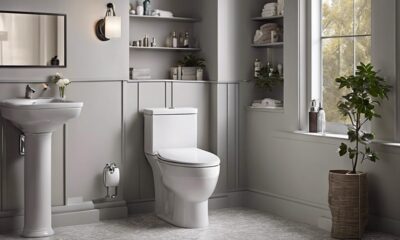
 Vetted2 weeks ago
Vetted2 weeks ago15 Best Tall Toilets for Seniors That Combine Comfort and Safety
-

 Vetted2 weeks ago
Vetted2 weeks ago15 Best Dish Scrubbers to Keep Your Kitchen Sparkling Clean
-

 Beginners Guides4 weeks ago
Beginners Guides4 weeks agoDesigning Your Retreat Center – Essential Tips
-

 Beginners Guides4 weeks ago
Beginners Guides4 weeks agoAre Retreats Profitable
-
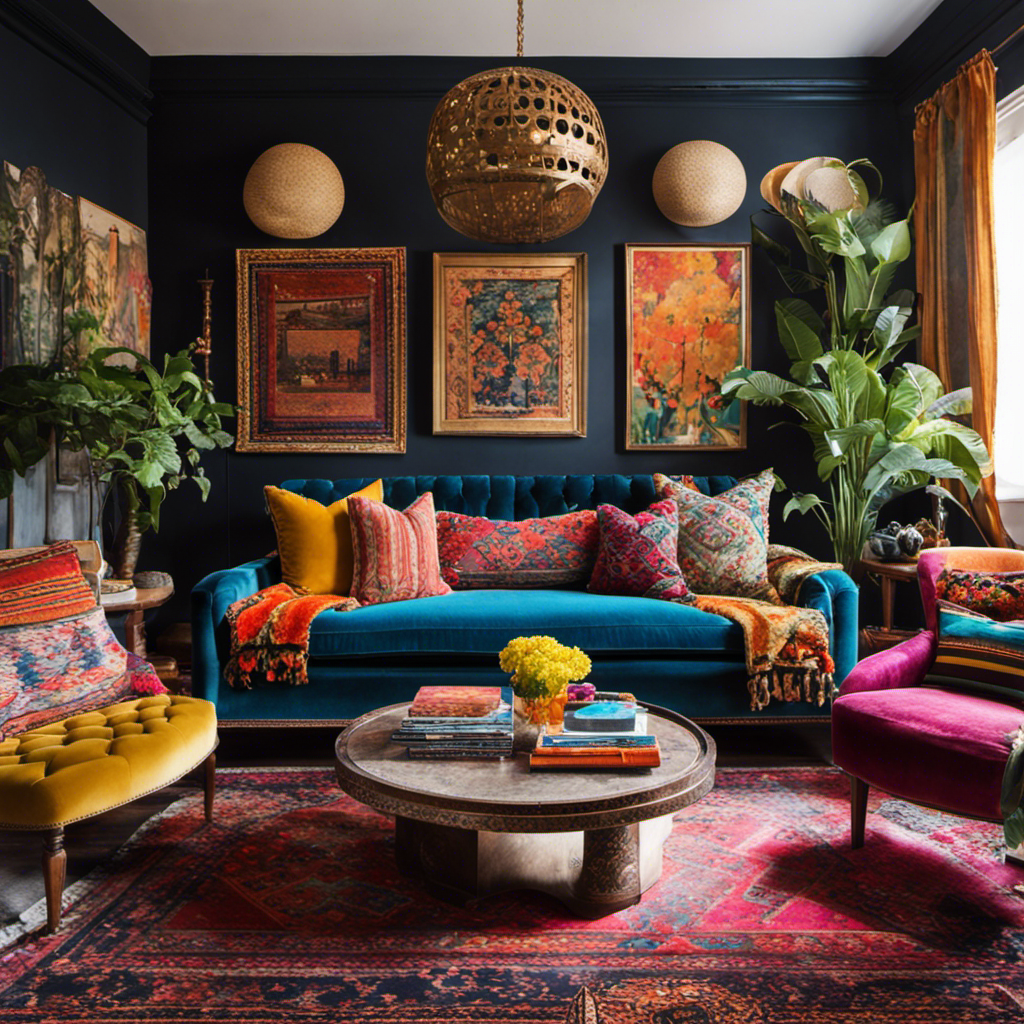
 Decor2 weeks ago
Decor2 weeks agoWhat Is Eclectic Home Decor




